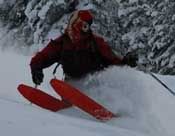This was part of my thesis with uni - I thought it could be of interest to some.
Background
My thesis was on torsional stiffness and vibration control in snowboards. I built two snowboards - a reference snowboard with basic layup (base, edges, vds along edges, wood core, two layers of 22oz triax, wood veneer topsheet, inserts) and a damped snowboard (identical, but with 0.2mm VDS in the direction of the second torsional mode).
The reason behind trying to control vibrations in snowboards or skis is to increase edge hold at high speed, and decrease injury through Human Response to Vibration (HRV). The The frequency response of snow has been measured to be between 20-80Hz, which has been confirmed to match K2's research by a K2 engineer (yes, I can supply a reference here if necessary). Vibrations have been shown to have negative effects on humans below 100Hz, therefore this project focussed on the range of 0-125Hz. Vibrations above this range would have negligable effect on edge hold or injury to the rider.
To determine the torsional modes and frequency response, I used a laser vibrometer with an electromagnetic shaker, and used a rectangular scanning grid on the surface of the board, as seen below:

Torsional and Bending modes are the natural frequencies of the snowboards that cause it to deflect. The modal shapes of a snowboard can be seen below:

These are rectangular as this was the shape of the scanning grid.
The layup of the VDS can be seen here for the damped board:

Results
The results can be seen below in the frequency response graph of each board.

The graph above shows the response of the reference snowboard and the damped snowboard. Here we would expect to see the peaks occurring at the same frequencies, with the damped snowboard showing lower peaks than the reference board, especially at the second torsional mode (the peak around 71Hz).
We see that the peaks for the damped board are slightly earlier, which indicates the board is slightly softer, which is probably due to minor differences in the wood core.
Importantly though, the peaks in the damped board are the same height or slightly higher, particularly in the second torsional mode. This indicates that the VDS used has zero damping effects below 125Hz.
What we can conclude from this is that VDS is used, as many on the forum have suggested, as a gasket between the edges and the first fibreglass layer, and not for vibration damping at all.
Note: I used 0.2mm VDS here. Thicker VDS may have an impact on vibrations in the lower frequencies, however from my research I do not believe that any effective vibration damping would happen with a thickness of less than about 1.2mm, which is pretty thick to be putting in a board layup without cutting some serious grooves in your core to allow it.


